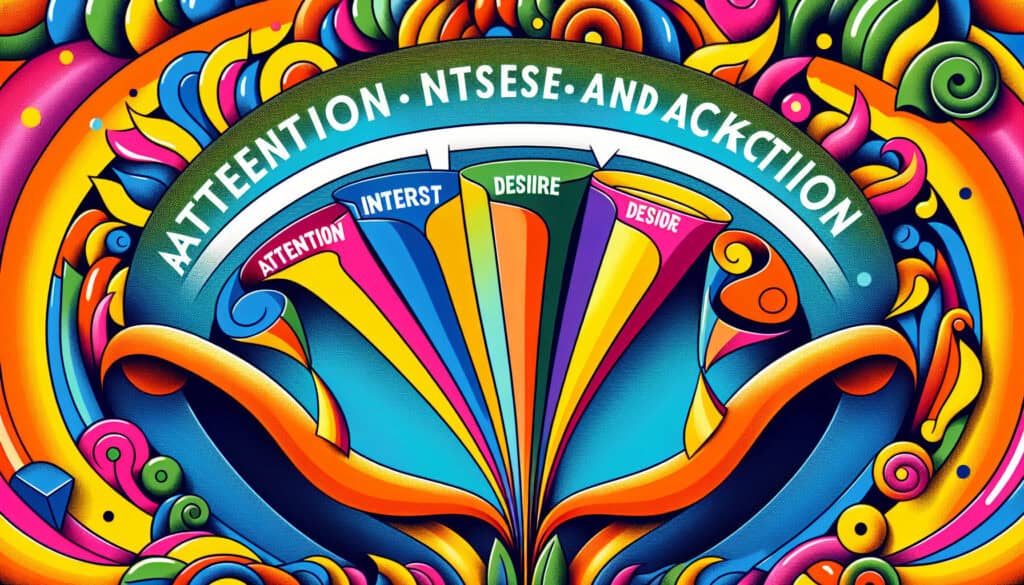A marketing and advertising model that describes the stages a consumer goes through before making a purchase.
- Methodologies: Customers & Marketing, Ideation, Product Design
AIDA Model

AIDA Model
- Brand Positioning, Customer Experience, Customer Journey Mapping, Marketing, Marketing Strategy, Product Development, Product Management, Value Proposition
Objective:
How it’s used:
- The AIDA model consists of four stages: Awareness (or Attention), Interest, Desire, and Action. It is used to guide the creation of marketing and advertising campaigns.
Pros
- Provides a simple and effective framework for creating marketing campaigns, helps to understand the customer journey, and can be applied to a wide range of marketing channels.
Cons
- Is a linear and simplified model of the customer journey, may not be applicable to all types of products or services, and does not account for post-purchase behavior.
Categories:
- Customers & Marketing, Product Design
Best for:
- Guiding the development of marketing campaigns that effectively move consumers through the purchase funnel.
The AIDA model finds its applications across various sectors, particularly in consumer goods, technology, and services, where understanding buyer behavior and engagement is paramount. In the project execution phase, teams can adopt this model during market research and product launch initiatives, providing a sequential approach that aligns marketing efforts with consumer expectations. For example, in the automotive industry, advertisers may capture Attention through eye-catching visuals or thrilling advertisements, spark Interest by demonstrating features or innovations, create Desire through emotional storytelling or emphasizing safety and performance, and ultimately prompt Action with promotions or easy access to purchase channels. This methodology is not limited to marketing teams; it can involve cross-functional collaboration with product designers and engineers to ensure that the messaging aligns with the actual user experience, enhancing authenticity. Using the AIDA model can also guide businesses in refining their customer relationship management strategies, as it facilitates the development of targeted content for multiple communication platforms, enhancing engagement on social media, email newsletters, and online advertising. Consequently, its simplicity encourages frequent reassessment and adaptation in campaigns, making it suitable for both established brands and startups looking to establish a foothold in competitive markets.
Key steps of this methodology
- Create awareness through targeted advertising and promotions. <li Draw interest by presenting unique features and benefits of the product. <li Cultivate desire by showcasing testimonials and compelling use cases.
- Encourage action with clear calls to action and urgency in messaging.
Pro Tips
- Utilize data analytics to refine targeting strategies during the Awareness phase, enabling more personalized outreach that captures attention effectively.
- Incorporate storytelling in the Interest and Desire stages to create emotional connections, making the value proposition resonate deeply with the audience.
- Implement A/B testing across various platforms to optimize Calls to Action in the Action phase, ensuring maximum conversion rates.
To read and compare several methodologies, we recommend the
> Extensive Methodologies Repository <
together with the 400+ other methodologies.
Your comments on this methodology or additional info are welcome on the comment section below ↓ , so as any engineering-related ideas or links.
Historical Context
1960
1980
1983
1990
1995
2000
2010
1950
1980
1980
1986
1994
1995
2000
(if date is unknown or not relevant, e.g. "fluid mechanics", a rounded estimation of its notable emergence is provided)














Related Posts
Musculoskeletal Discomfort Questionnaires
Multivariate Testing (MVT)
Multiple Regression Analysis
Motion Capture Systems
MoSCoW Method
Mood’s Median Test